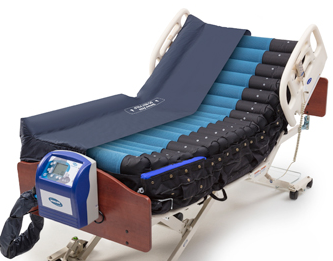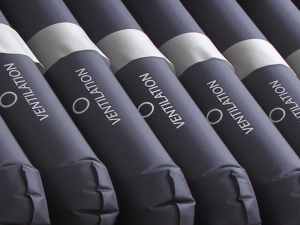






If you are in a hospital or need to stay in bed in the comfort of your home for any amount of time, a low air loss mattress might be a good choice. As well as helping you maintain a comfortable position, a low air loss mattress can also relieve pressure on vital areas of your body. Low air loss and alternating pressure mattresses are the two most popular types of medical air mattresses recommended for individuals who are at risk of bed sores.
Low air loss mattresses are designed to distribute the patient’s body weight over a broad surface area and help prevent skin breakdown. Air continually flows through tiny laser-made air holes in the top of the mattress surface so that the user floats on a soft cushion of air. True air loss mattresses feature greater airflow to maintain optimal skin temperature and moisture levels.
Alternating pressure air mattresses provide additional protection with rows of air cells that gently switch between inflation and deflation. The pressure changes cycle every 10-25 minutes and are not noticeable to the user. This shifts the person’s weight to prevent constant pressure on fragile skin areas and also promotes blood flow to tissues.

Individuals who spend long periods of time in bed can develop bed sores from prolonged pressure on skin areas. These wounds can develop anywhere on the body but are most common on the heels, spine and hips. The alternating pressure uses pressure redistribution to stimulate blood circulation and pressure relief to anyone sleeping on it. These air mattresses provide constant relief to the person sleeping on one while reducing the need for the need for manual repositioning by a loved one.
A low air loss mattress is essentially an air mattress covered with tiny holes. These holes are designed to let out air very slowly which helps keep the skin dry and wicks away any moisture. Alternating pressure mattresses alternates inflation and deflation of air cells that constantly moves pressure from different parts of the body.
Fitted sheets should not be used over low air loss mattresses because they compress the air cells and restrict air flow. Thin knit or jersey material flat sheets should be used instead. Low air loss mattress covers are specially designed to allow air flow to pass through and prevent moisture buildup. This creates a microclimate between the skin and mattress to keep the user comfortable and prevent skin breakdown. Quilted reusable pads and incontinence briefs will block airflow and trap moisture against the skin. Disposable air-permeable incontinence pads designed for use with low air loss mattresses should be used instead.
HomeCare Air 6000 Low Air Loss & Alternating Pressure Mattress
The HomeCare Air 6000 Low Air Loss & Alternating Pressure Mattress combines low air loss with alternating pressure therapy. The 80”L x 36”W x 8” H mattress has a 450 lb weight capacity. The quilted nylon top cover is fluid-resistant and anti-microbial to provide a cool, dry surface for comfortable sleep.
Top Features:
Span America PressureGuard Protocol™
The Span America PressureGuard Protocol is 35” wide mattress has a 400 lb weight capacity while the 42” width can accommodate users up to 500 lbs. The quiet air pump features adjustable pressure levels for comfort and will maintain pressure during power failure. A 30-minute auto-firm function provides stability during bathing and activities of daily living. An 18-month warranty is included.
Top Features:
Invacare MicroAir MA1000
The Invacare MicroAir MA1000 features true low air loss therapy with a 1275 liter/minute high powered pump. The 80”L x 36”W x 10” H mattress has a 600 lb. weight capacity. The 3:1 alternating pressure feature inflates and deflates cells to support ⅔ of the body at any given time. Cycle times are customizable with 10 adjustable control settings for individualized comfort. A convenient Auto Set Mode continually monitors and adjusts pressures based on the user’s height, weight and position.
Patient Care Mode provides quick maximum inflation to help with bathing or activities. The quilted nylon cover is comfortable against the skin and intentionally oversized to reduce friction. A limited one year warranty is included.
Overall, both types of mattresses are useful for reducing pressure on skin areas keeping you comfortable while bed-ridden. We hope you find the medical air mattresses we previously featured as great options to explore. As always, please consult with your doctor who can guide you through on the best approach for you or your loved one.
At HomeCare Hospital Beds we want to help you make an informed decision. If you have any doubts on which low air loss or alternating air mattress is best for you, please contact our HomeCare Hospital Beds team so we can help you make the right choice. Call us today toll free at 877-414-0002 or email us at info@homecarehospitalbeds.com.




| Cookie | Duration | Description |
|---|---|---|
| cookielawinfo-checkbox-analytics | 11 months | This cookie is set by GDPR Cookie Consent plugin. The cookie is used to store the user consent for the cookies in the category "Analytics". |
| cookielawinfo-checkbox-functional | 11 months | The cookie is set by GDPR cookie consent to record the user consent for the cookies in the category "Functional". |
| cookielawinfo-checkbox-necessary | 11 months | This cookie is set by GDPR Cookie Consent plugin. The cookies is used to store the user consent for the cookies in the category "Necessary". |
| cookielawinfo-checkbox-others | 11 months | This cookie is set by GDPR Cookie Consent plugin. The cookie is used to store the user consent for the cookies in the category "Other. |
| cookielawinfo-checkbox-performance | 11 months | This cookie is set by GDPR Cookie Consent plugin. The cookie is used to store the user consent for the cookies in the category "Performance". |
| viewed_cookie_policy | 11 months | The cookie is set by the GDPR Cookie Consent plugin and is used to store whether or not user has consented to the use of cookies. It does not store any personal data. |